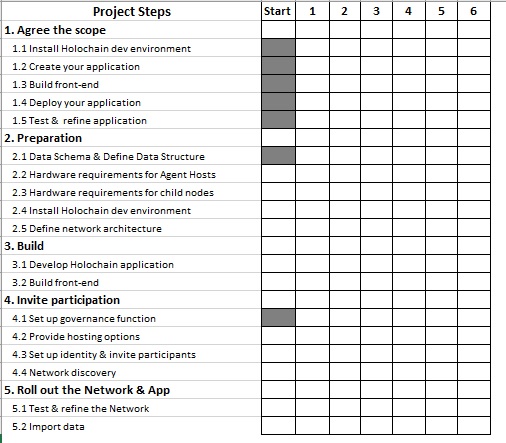
ChatGPT Generated Project Plan
OVERVIEW
-
-
-
-
-
-
-
-
- Agree the Scope
- Preparation
- Build
- Invite Participation
- Roll out the Network and Application
-
-
-
-
-
-
-
Based on responses to a ChatGPT series of questions the following ChatGPT Generated Project Plan has been constructed for detailed analysis and completeness.
All of the content has been derived from the ChatGPT responses and rearranged into a format to enable a project plan with detailed hardware and network requirements and action items.
1. Agree the scope
Setting up a Holochain web3 platform involves several steps. Here is a general outline of the process:
1.1 Install the Holochain development environment: You can install the Holochain development environment by following the instructions provided in the Holochain documentation. This will include installing the Holochain CLI, setting up your development environment, and configuring your system for Holochain development.
1.2 Create your Holochain application: Once you have set up your development environment, you can start creating your Holochain application. Holochain provides a development framework that allows you to create distributed applications with ease. You can use the Holochain CLI to create a new application and define its schema, rules, and validation logic.
1.3 Build your front-end: Once you have created your Holochain application, you will need to build your front-end. You can use any front-end framework that you are comfortable with, such as React, Angular, or Vue.js. You will need to use the Holochain API to interact with your Holochain application from your front-end.
1.4 Deploy your Holochain application: Once you have built your Holochain application and front-end, you can deploy it to the Holochain network. Holochain allows you to deploy your application on a peer-to-peer network, which means that there is no need for a centralized server. You can use the Holochain CLI to deploy your application and start interacting with it.
1.5 Test and refine your application: Once your application is deployed, you can start testing it and refining it. You can use the Holochain CLI to test your application’s functionality and performance. You can also use the Holochain debugging tools to identify and fix any bugs or performance issues.
Overall, setting up a Holochain web3 platform requires a good understanding of Holochain’s development framework and the ability to work with front-end technologies. It can be a complex process, but with the right tools and resources, you can create powerful, decentralized applications that can transform the way we interact with each other online.
2. Preparation
2.1 Create a Data Schema and publish a standard to Define Data Structure
Note, the HR-CSAS standard mentioned below has been replaced by the HR-DPS (HR Data Platform Standard and the HR-BCDS (HR Blockchain Data Standard)
The HR-CSAS (Human Resource Component Software Application Standard) is a software standard that defines a set of components and interfaces for building human resource software applications. While it can provide a useful reference point for developing HR applications, it is not specifically designed for use with Holochain.
Holochain is a distributed computing platform that enables developers to build decentralized applications that are highly scalable and secure. While the HR-CSAS may be useful as a guide for developing certain components of an HR application, it is important to keep in mind that developing decentralized applications on Holochain involves different design considerations and approaches compared to traditional, centralized HR applications.
Therefore, while the HR-CSAS may provide some useful guidance in the development of HR applications, it is not necessarily a direct reference for building applications on Holochain. Developers building Holochain-based HR applications should consider the unique features and capabilities of the platform, as well as the principles of decentralized design, to ensure that their applications are optimized for the Holochain environment.
2.2 Prepare for hardware requirements for Agent Hosts
The hardware and computing requirements for setting up a node on a Holochain network will depend on several factors, such as the complexity of the application, the number of nodes in the network, and the amount of data being processed and stored. Here are some general guidelines to help you determine the minimum hardware and computing requirements for a Holochain node:
2.2.1 CPU: A modern CPU with multiple cores and threads is recommended to handle the workload of running a Holochain node. A minimum of a quad-core CPU with 2.5 GHz clock speed is recommended.
2.2.2 RAM: Holochain nodes require a significant amount of memory, as they need to maintain a copy of the distributed hash table (DHT) and run the Holochain application logic. At least 8 GB of RAM is recommended, but more may be necessary depending on the complexity of the application and the number of nodes in the network.
2.2.3 Storage: Holochain nodes require local storage to store the DHT and other application data. The amount of storage required will depend on the size of the application and the amount of data being processed and stored. A minimum of 256 GB of storage is recommended.
2.2.4 Network bandwidth: Holochain nodes need to communicate with other nodes in the network to synchronize data and execute transactions. A stable internet connection with a minimum of 10 Mbps bandwidth is recommended.
2.2.5 Operating system: Holochain runs on various operating systems, including Windows, Mac OS, and Linux. The recommended minimum operating system requirements for running a Holochain node are the same as those of the respective operating system.
It’s important to note that these are general guidelines, and the actual hardware and computing requirements may vary depending on the specific needs of your Holochain application and network. It’s always a good idea to consult with experienced Holochain developers and review the official Holochain documentation for more detailed information.
2.3 Prepare for hardware requirements for child nodes
The minimum hardware and computing requirements for a child node on a Holochain network depend on the specific needs of the application and the number of transactions that the node needs to process. However, if the dataset is very small and the number of transactions is limited, a low-powered device such as a Raspberry Pi can be sufficient to run a Holochain node.
Here are some general guidelines for the minimum hardware and computing requirements for a child node with a small dataset:
2.3.1 CPU: A low-powered CPU, such as a 1 GHz single-core ARM processor, can be sufficient for a child node with a small dataset.
2.3.2 RAM: For a small dataset, a minimum of 2 GB of RAM should be sufficient. Holochain nodes require a significant amount of memory, but a small amount may be sufficient.
2.3.3 Storage: A child node a minimum of 16 GB of storage, with a small dataset may be required.
2.3.4 Network bandwidth: A stable internet connection with a minimum of 1 Mbps bandwidth should be sufficient. The amount of network bandwidth required for a child node with a small dataset is minimal, as the amount of data being transmitted is low.
2.3.5 Operating system: Holochain runs on various operating systems, including Windows, Mac OS, and Linux. The recommended minimum operating system requirements for running a Holochain node are the same as those of the respective operating system.
It’s important to note that these are general guidelines, and the actual hardware and computing requirements may vary depending on the specific needs of your Holochain application and network. It’s always a good idea to consult with experienced Holochain developers and review the official Holochain documentation for more detailed information.
A Raspberry Pi is a small, low-cost computer designed to promote computer science education and experimentation. It was first released in 2012 by the Raspberry Pi Foundation, a UK-based charity organization that aims to teach people of all ages how to program and build computers.
The Raspberry Pi is about the size of a credit card and comes with a range of input/output ports, such as USB, HDMI, and Ethernet, as well as built-in Wi-Fi and Bluetooth connectivity. It runs on a version of the Linux operating system and can be used for a wide range of applications, including home automation, media centers, and robotics.
2.4 Install the Holochain development environment
You can install the Holochain development environment by following the instructions provided in the Holochain documentation. This will include installing the Holochain CLI, setting up your development environment, and configuring your system for Holochain development.
2.5 Define the network architecture
The first step is to define the architecture of your Holochain network, including the number of nodes, the topology of the network, and the roles and responsibilities of each node. You will also need to consider how data will be stored, synchronized, and shared across the network.
3. Build
3.1 Develop the Holochain application
Once you have set up your development environment, you can start creating your Holochain application. Holochain provides a development framework that allows you to create distributed applications with ease. You can use the Holochain CLI to create a new application and define its schema, rules, and validation logic.
The Holochain CLI (Command Line Interface) is a tool provided by the Holochain framework that allows developers to create, manage, and deploy Holochain applications from the command line. The Holochain CLI is a set of command-line tools that developers can use to interact with the Holochain framework and build their applications.
The Holochain CLI provides a range of functions, including creating a new Holochain application, generating templates for DNA (Distributed Network Application) code, compiling and building your Holochain application, and deploying it to the Holochain network. Additionally, it provides tools for managing DNA instances, configuring the Holochain environment, running tests, and debugging.
Using the Holochain CLI, developers can easily create and deploy decentralized applications that can run on the Holochain network. The CLI is an essential tool for anyone looking to build applications on top of the Holochain framework, as it provides a convenient and efficient way to manage the development and deployment process
3.2 Build your front-end
Once you have created your Holochain application, you will need to build your front-end. You can use any front-end framework that you are comfortable with, such as React, Angular, or Vue.js. You will need to use the Holochain API to interact with your Holochain application from your front-end.
4. Invite participation
4.1 Set up the governance function
Once the Holochain application is developed, you will need to set up a governance function to define the rules and policies that will govern the behavior of the network participants. This may involve creating smart contracts or other software components to enforce the rules and policies.
The first step in setting up a governance function is to define the governance structure for the network. This involves deciding on the roles, responsibilities, and decision-making processes for members of the network. You should consider factors like the size and complexity of the network, the types of decisions that need to be made, and the level of participation you want to encourage.
4.1.1 Implement the governance rules in the DNA code: Once you have defined the governance structure, you need to implement the governance rules in the DNA code for your Holochain application. This involves writing the rules and functions that allow members of the network to participate in the decision-making process. You may need to consult the Holochain documentation or seek the assistance of a developer to implement the necessary code.
4.1.2 Test and deploy the application: After implementing the governance rules, you need to test and deploy the Holochain application to the network. This involves creating a new DNA instance and deploying it to the nodes in the network. You should test the application thoroughly to ensure that the governance rules work as intended and that members of the network can participate in the decision-making process.
4.1.3 Establish a process for governance decisions: Finally, you need to establish a process for governance decisions. This may involve creating a proposal system, where members of the network can propose changes or decisions and vote on them. Alternatively, you may choose to have a more informal process, where members can participate in open discussions and make decisions through consensus-building
4.2 Provide participants with hosting options
A proxy hosting agent on a Holochain network can host a company (parent) and its children. In fact, this is one of the strengths of the Holochain architecture, as it allows for flexible and decentralized hosting of applications.
Regarding governance, it would depend on the specific design of the application and how the parent and child entities are organized within it. Holochain applications are typically designed with a focus on distributed governance, where all participants have a say in the decision-making process.
In this case, the parent entity could be responsible for setting rules and policies for the child entities, and participants within each entity could have a say in how those rules are enforced. Alternatively, each entity could have its own governance structure, with the parent entity acting as a facilitator or coordinator between them.
Ultimately, the specific governance model would depend on the needs and goals of the application, and would need to be carefully designed and implemented by the application developers.
4.3 Set up identity and invite participants to join the network
It is possible to allocate companies an identity and other credentials prior to joining a Holochain network. In fact, one of the advantages of Holochain is its flexibility in terms of identity management and access control.
Holochain applications can define their own identity and access management protocols, which can be customized to meet the specific needs of the application and its users. This allows companies to establish their own unique identity and credentials that can be verified by the network prior to joining.
For example, a Holochain application might require that companies provide certain identifying information, such as a company name, address, and tax identification number, in order to join the network. Additionally, the application might require that companies provide additional credentials, such as proof of insurance or a business license, in order to access certain features or data within the network.
By establishing these identity and access controls prior to joining the network, Holochain applications can help to ensure the integrity and security of the network while also providing a seamless user experience for participating companies.
4.4 Network discovery
In a Holochain network, clients can reach other clients through a process called “peer discovery”. Peer discovery is the mechanism by which nodes in the network find and connect to each other.
When a client joins the Holochain network, it sends a request to the network to find other nodes that are running the same application. This request is broadcast to other nodes on the network, which respond with information about themselves, including their IP address, port number, and the application instance they are running. This information is stored in the client’s local “peer cache”, which maintains a list of all the nodes that the client can connect to.
Once a client has a list of available nodes, it can establish a connection to one or more of them using a secure protocol like WebSockets or HTTP. Once the connection is established, the client can exchange data and messages with other nodes in the network.
Holochain uses a peer-to-peer (P2P) network architecture, which means that there is no central server or authority that controls the network. Instead, each client in the network has equal status and can participate in the network’s governance and decision-making processes. This distributed architecture allows for greater scalability, resilience, and privacy than traditional centralized networks.
5. Roll out the Network and Application
5.1 Test and refine the Network
Finally, you should test the Holochain network, refine the governance function and the application as necessary, and optimize the network performance and scalability.
5.2 Import data
Once the participants have joined the network, you can import data from a CSV file for their children nodes. This will involve converting the CSV file to a compatible format, parsing the data, creating new entries in the DHT, and validating the data.
It is possible to import data from a CSV file into a Holochain application. However, the specific process will depend on the design of your Holochain application and the format of the CSV file.
Here is a general process for importing data from a CSV file into a Holochain application:
5.2.1 Define the data schema: The first step is to define the data schema for your Holochain application, which specifies the data structure and validation rules. This will involve creating the appropriate DNA code and defining the necessary entry types, validation rules, and other data structures.
5.2.2 Convert the CSV file to a compatible format: The next step is to convert the CSV file into a format that is compatible with your Holochain application. This may involve using a tool to convert the CSV file into JSON or another format that can be easily parsed by your Holochain application.
5.2.3 Parse the data and create entries: Once you have the data in a compatible format, you can use Holochain’s API to parse the data and create new entries in the DHT. This will involve using the appropriate Holochain functions to create new entries for each row of data in the CSV file.
5.2.4 Validate the data: After importing the data, you will need to validate it to ensure that it conforms to the data schema for your Holochain application. This will involve using the appropriate validation functions in your Holochain code to check that the data is valid and consistent with the schema.
5.2.5 Test and refine the process: Finally, you should test the process of importing data from a CSV file and refine it as necessary to ensure that it works reliably and efficiently.
Overall, importing data from a CSV file into a Holochain application is possible but will require careful planning and implementation. You may want to consult with experienced Holochain developers or seek out training resources to help you get started.
Timeline Development

